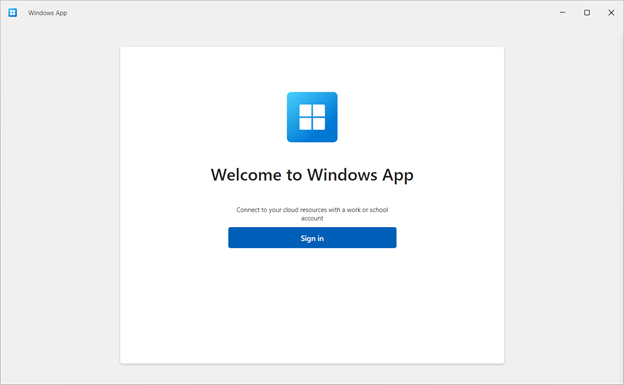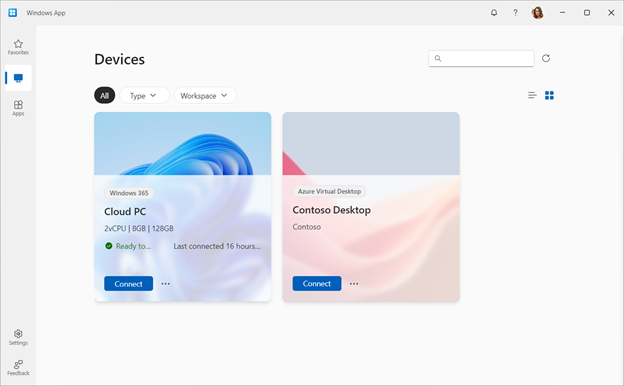Windows App: Everything You Need to Know
As of November 27, 2024, the Azure Virtual Desktop Preview app is no longer available for download or installation, with support ending on December 27, 2024. Transitioning to the Windows App is essential to maintaining uninterrupted service.
What is the Windows App?
The Windows App is a tool that allows users to connect to their Windows desktops and applications from anywhere. It is available on Windows, macOS, iOS/iPadOS, and Android/Chrome OS.
Use Cases
The Windows App can be used for various purposes, including:
- Remote work and accessing business applications from anywhere.
- Accessing a work computer from a personal device.
- Providing remote technical support.
- Collaborating with colleagues remotely.
- Using virtual desktops for business or personal use.
Key Benefits
- Unified Access – Manage and access multiple Windows services from a single interface, including cloud PCs, virtual desktops, and local PCs.
- Customizable Experience – Personalize the interface with customizable home screens, multi-monitor support, and dynamic display resolutions.
- Secure and Reliable – Provides a secure connection to desktops and applications.
- User-Friendly – Simple setup and intuitive interface.
- Cross-Platform Availability – Available on multiple platforms.
- Free for Personal Use – No additional costs for personal users.
Key Differences: Windows App vs. Azure Virtual Desktop (AVD)
- Purpose – The Windows App prioritizes ease of use with a unified interface, while AVD is a dedicated Virtual Desktop Infrastructure (VDI) solution.
- User Base – Windows App caters to end-users needing simple, seamless access, while AVD is designed for enterprises requiring advanced customization and management.
- Management – AVD offers extensive customization and scalability, while the Windows App requires minimal setup.
- Integration – AVD integrates deeply with Azure services, whereas the Windows App acts as a versatile gateway to multiple environments.
Transitioning from Azure Virtual Desktop Preview to Windows App
To ensure a smooth transition, follow these steps:
1. Enable Windows App from Azure Virtual Desktop Preview
- Open Azure Virtual Desktop Preview.
- Click the “Try the Windows App” toggle below the title bar to initiate the switch.
2. Familiarize Yourself with the Windows App
- Review the “Get Started with Windows App” guide to help update internal processes and provide user support.
3. Inform Impacted Users
- Follow organizational change-management procedures to notify users of the transition.
- Provide walkthroughs, quick-start guides, and other educational resources.
4. Deploy Windows App and Uninstall AVD Preview
- Use endpoint management systems, scripts, or other deployment methods.
- Remove the Azure Virtual Desktop Preview app from devices.
Known Limitations on Windows Machines
At present, Microsoft has noted the following limitations:
- Resetting user data through the UI isn’t supported; use Windows settings instead.
- Integration with Windows Start Menu is unavailable.
- Private Link connectivity to AVD is not supported.
- Single Sign-On (SSO) with AD FS is not supported.
- Connections to certain Azure environments (Azure Government, Azure Germany, Azure operated by 21Vianet, and Azure Virtual Desktop Classic) are not supported.
- Proxy servers requiring authentication may prevent Windows App from functioning.
- Windows App Insider ring is temporarily disabled.
Using the Windows App
To connect to your devices and applications from Azure Virtual Desktop:
1. Download and Install Windows App
- Install from the Microsoft Store.
- Download the .msix file: Windows App from the Microsoft Store for deployment.

2. Sign In
- Select Sign in. This process may be automatic if you are already signed in with a work or school account.
3. Access Remote Resources
- After signing in, select the Devices or Apps tab to view assigned remote resources.
- If no devices or apps appear, an administrator must assign them to you.
4. Connect to a Device or App
- Select Connect on the desired device or app.
- Depending on organizational policies, you may be prompted to enter your password again.
5. Begin Using Your Remote Desktop
- Once connected, you can start using your remote desktop or applications.

In summary, with the discontinued Azure Virtual Desktop Preview app, transitioning to the Windows App is crucial for continued remote access. The Windows App offers a unified and user-friendly interface for connecting to Windows desktops and applications across multiple platforms. While there are some current limitations, the Windows App provides essential features for remote work, technical support, and virtual collaboration, making it a suitable replacement.
For more information, please contact us.

